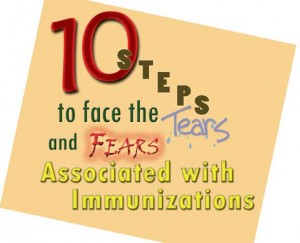by Laurie LaMonde, PhD Clinical Psycholo gist. Laurie is a member of Raising Multiples/MOST and a former board member. She is also the mother to triplets and 2 singletons.
gist. Laurie is a member of Raising Multiples/MOST and a former board member. She is also the mother to triplets and 2 singletons.
Many of these guidelines might be beneficial for children having to endure any invasive medical procedure (venipuncture, dental visits, etc.). Be creative – you know your children and their interests the best. Often, just your presence may be all the comfort they need!
If you have any additional ways that have helped your family cope with immunizations, please feel free to post them on facebook, this blog and/or contact the Raising Multiples/MOST office so that we can pass it along to other parents. ♥♥
Once my children were able to talk, the dreaded question would always surface when we headed to the pediatrician’s office. As a parent, do we tell them the truth and hear the dreaded moans, as we have to peel them out of the van as they scream in terror, or do we say that we aren’t sure? The battles change as the children age, but the old adage “no pain, no gain” holds true for immunizations. Based on the Centers for Disease Control and Prevention recommendations, a child may face up to 20 injections by age 2; however, the rate of previously fatal diseases has steadily declined.
At some point in parenthood, we realize that we cannot always stop the pain our children face, and sometimes we (literally) sign up for it. It is difficult to watch a child endure multiple vaccinations; however, it can be even more painful to witness them suffer from an illness that may have been preventable. Regardless if it is immunizations, antibiotic injections, flu shots or other invasive medical procedures, preparation is always the key to success.
Regardless of your own careers or experiences, nothing fully prepares you for the day that it is your children screaming in the pediatrician’s office – and the somber look of the other parents as you leave and they realize that you had multiples to vaccinate to boot! However, with the proper preparation and guidance, you can acquire a few proven techniques to ease your children’s anxiety – and yours!
Although there are no miracle cures, these are 10 suggestions on making immunizations more bearable. This list is not all encompassing and parents should select what they feel might work best for their family, based on their children’s disposition, developmental stage and prior experiences.
Step #1 Prepare Yourself: Just like a hurricane, if you know it’s coming, then you’d better prepare! The following list of suggestions may help you ease through immunization appointments with multiples in tow. Remember to remain flexible (i.e., there may be new immunizations or a shortage of vaccinations the day of your appointments) and to do your research ahead of time (if you prefer to research the benefits and risks associated with each immunization so that your children are not witnessing you in conflict about the decision while they are waiting in agony!). Also, if you tend to be anxious about injections, be sure to prepare yourself since research has shown that parents who act distressed have children that are more distressed!
Step #2 Anticipatory Anxiety: Research tends to show that children who knew that they were receiving a vaccination adjusted better than those who were not told (again, depending on their age and prior experiences). While it is important to be honest with your children, timing is also important. If you inform your 3-year- old set of multiples that they are going to have shots next week, the anxiety will build all week and potentially have a disastrous outcome. Studies have not found conclusive windows of ideal opportunity to inform children, so use your own judgment to determine what might be best for your family. When discussing immunizations, it is important to discuss why the vaccinations are important (medicine to help them stay healthy), to acknowledge that there is brief pain (like an insect bite that resolves quickly), and to recommend some techniques to help reduce their pain and anxiety (coping techniques such as breathing exercises, progressive muscle relaxation, visualization, meditation, etc., reviewed under #7). Parents should con- sider what information might be most beneficial depending on each child’s level of comprehension and state of anxiety. With multiples, the tendency for one child’s anxiety to increase another’s anxiety is normal and may need to be addressed to prevent a catastrophic meltdown.
Step #3 Pre-Screaming: Prior to the injections (you will likely be busy consoling your children after the injections), be sure to have your other questions addressed and check with your provider on recommendations following procedures (i.e., potential side-effects, methods of reducing pain, such as the need for any medications or the benefits of having the children move their arms to prevent stiff- ness, etc.). FYI – the “Chicken Dance” works wonders on reducing arm pain by minimizing stiffness and causing a case of the giggles!
Step #4 Be a Model: Your children are watching you. If you act upset, they are likely to follow suit. Your demeanor impacts their adjustment. Specifically, a recent study found that “excessive parental reassurance, criticism, or apology seems to increase distress, whereas humor and distraction tend to decrease distress” (Schechter, Zempsky, Cohen and col- leagues, 2007, Pediatrics p. e1184).
Step #5 Distraction Techniques: Various methods of distraction have been found to be effective, depending on age. 
+ With children under six months, a pacifier with sucrose has been found to be effective in reducing distress and can easily be prepared in advance for multiples. Some practitioners recommend having a bottle (or nursing) infants after they were immunized since feeding is typically associated with comfort at this age.
+ Depending on the children’s age and interests, other methods of distraction may include: bubbles (staff at some facilities will blow bubbles after the injections, or bring your own), balloons, treasure chests (provided by the office) or rewards for “bravery” (provided by the parent, such as an inexpensive dollar store item). Some facilities have books, television shows and/or video games for the children to distract them from procedures. Additional studies have supported other methods of distraction, such as party blowers, kaleidoscopes and music.
+ Some parents provide their children with a lollipop or comparable treat. With such items, care must be given to ensure that the item is not a choking hazard (if the child is hysterical), permitted within the office (many office policies restrict such items), and in a sterile environment (you wouldn’t want the lollipop to drop on the floor or other surfaces in a pediatrician’s office!). Overall, any treat often brings joy, which typically ends the crying spell.
+ Humor has also been shown to be very effective in minimizing children’s dis- tress. For example, telling jokes or playing games (from peek-a-boo, to “I Spy,” or “Simon Says”) can bring laughter among the children and distracts them from their surroundings. After all, happiness and anxiety typically cannot co-exist at the same time!
Step #6 Comfort Items: Parents often forget that they are typically their children’s best comfort item. Many providers have parents embrace their child during procedures, which may help the child adjust. (I was always afraid that our children would associate me with the pain if I was holding them, but this is not the case your embrace is very soothing and, in time, they know it is the medical staff that is providing the immunizations!). Be sure to relate your level of comfort with hold ing your child during procedures with the provider. Additional comfort items may include blankets, their favorite stuffed animals, coloring books, or other toys (and surprising them with these comfort items at their time of need is often wonderfully comforting – and distracting!).
Step #7 Techniques: There are several proven methods of reducing anxiety and, depending on the children’s cognitive abilities, may include:
+ Breathing exercises: Simply having your children breathe in slowly and deeply and then releasing their air slowly, repeat as necessary (if younger, party blowers or blowing up balloons help mimic breathing cycles).
+ Progressive muscle relaxation: Have your child gently tighten/flex muscles and then release/relax muscles from their toes to their forehead. When younger, it can be a game to furrow their foreheads and shoulder – or play “Head, Shoulders, Knees and Toes” to stretch and relax.
+ Visualization: Have your child imagine a relaxing scene or place that holds fond memories (i.e., prior vacation, beach, play house). Ask them what they see, smell, touch, taste, and hear in their image to activate all senses for distraction and relaxation.
+ Meditation: Have your child sit in a relaxing pose and repeat a nonsense word that they make up (i.e., yaroodle). Repeating the nonsense words helps eliminate other stressors from entering their thoughts and a comfort- able position enhances their relaxation.
These skills are best acquired with practice and may be more beneficial if rehearsed. There are additional techniques (and enhancements to the ones noted), which you may find online, at a local library or from a medical professional.
Step #8 Multi-Tasking: When you are vaccinating multiples, it is best to seek the assistance of at least one other person to attend the appointment with you. If possible, seek someone that your child is comfortable with (spouse, partner, older sibling, relative, neighbor or caregiver). If you are unable to have someone assist you, ask the office staff if there might be someone on staff who could provide some extra assistance for immunization appointments. Decide how you plan to tackle immunizations with multiples. There are several options, depending on your provider, your scheduling abilities and your children’s interactions with one another. If children witness another sibling being immunized and upset, they will subsequently become anxious and will likely have an even more distressing experience. By the last of the multiple’s injections, it may be complete chaos! Check with your providers to see what has worked best in their experiences. Here are a few options:
+ Remain in one room and, if there is enough staff, have all the children immunized at the same time (caveat: painful for the parent in the recovery phase because there is only one of you – which is why extra hands help!).
+ You may be surprised – some children can provide adaptive role models for their siblings. During our last visit, one of my sons insisted on going first to show his brothers how “brave” he is and how “easy” the shots are (and, thankfully, despite three injections, he remained stoic!!).
+ Have the children taken to a different room to be immunized and returned to one room after they have calmed down (provided that there is another person to stay with the children waiting).
+ Some providers have suggested making appointments for the children on different days; however, for most parents this is not practical (multiple days for appointments and once the children can talk, they will go home and warn their siblings!).
+ If possible, have your children calm down prior to leaving so that they do not dread returning and have not learned that they must flee the doctor’s to avoid pain! Offices with treasure chests and/or stickers are often wonderful since children can be rewarded for their bravery and have a positive ending to their visit.
Step #9 Reminders and Praises: Be sure to remind your children (and yourself!) why the procedure is necessary since this may help reduce anxiety during their next appointment. In addition, remind them that shots are not required at every visit. If age appropriate, you may wish to provide a gentle reminder that the immunizations are important in reducing the likelihood of more serious illnesses (that, if not vaccinated against, could lead to hospitalizations and even more invasive procedures than a vaccination). It is also beneficial to acknowledge how each child acted bravely – even if they didn’t! This will build their self-esteem and booster their confidence in coping with the next immunization series.
Step #10 The Aftermath: Remember to take a minute for yourself at some point after the ordeal is over. Pat yourself on the back because it is stressful for a parent to watch one child endure a painful procedure. When it is in multiples, it pulls on you even more…and it is normal to feel exhausted!
Additional Resources:
CDC Immunization Schedule: http://www.cdc.gov/vaccines/schedules/index.html
Basics and Common Questions (CDC link): http://www.cdc.gov/vaccines/vac-gen/default.htm
For medical professionals: The study by Schechter and col- leagues (2007) also reviews data on needle length, intramuscular injection sites, topical anesthetics, and other areas relevant to invasive medical procedures. In addition, the study also appropriately notes that medical providers endure anxiety and distress associated with providing childhood immunizations. The abstract link is noted below.
Schechter, N. L., Zempsky, W. T., Cohen, L. L., McGrath, P. J., McMurtry, C. M. & Bright, N. S. (2007). “Pain reduction during pediatric immunizations: evidence-based review and recommendations.” Pediatrics, 119 (5), e1184-e1198. Abstract: http://pediatrics.aappublica- tions.org/cgi/content/full/119/5/e1184

